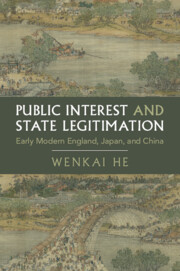Book contents
- Public Interest and State Legitimation
- Cambridge Studies in Historical Sociology
- Public Interest and State Legitimation
- Copyright page
- Dedication
- Contents
- Acknowledgments
- Introduction
- Part I Sources of Early Modern State Resilience
- 1 Legitimacy and Resilience of the Early Modern State
- 2 State–Society Collaboration against Subsistence Crisis
- 3 Financing Public Infrastructure
- 4 The Negotiation of State and Society over Redress of Grievances
- Part II The Emergence of Modern Politics
- Bibliography
- Index
2 - State–Society Collaboration against Subsistence Crisis
from Part I - Sources of Early Modern State Resilience
Published online by Cambridge University Press: 17 November 2023
- Public Interest and State Legitimation
- Cambridge Studies in Historical Sociology
- Public Interest and State Legitimation
- Copyright page
- Dedication
- Contents
- Acknowledgments
- Introduction
- Part I Sources of Early Modern State Resilience
- 1 Legitimacy and Resilience of the Early Modern State
- 2 State–Society Collaboration against Subsistence Crisis
- 3 Financing Public Infrastructure
- 4 The Negotiation of State and Society over Redress of Grievances
- Part II The Emergence of Modern Politics
- Bibliography
- Index
Summary
This chapter examines famine and poverty relief in Tudor and early Stuart England, Tokugawa Japan, and Qing China. Relief in subsistence crisis was the most basic obligation of the state to the public interest. The same platform of a public interest-based discourse of state legitimation led to two different directions in state–society interactions in famine relief. Tudor and early Stuart England and Tokugawa Japan had decentralized fiscal systems, and municipal and rural granaries managed by local authorities and social elites were dominant. Yet when a major subsistence crisis occurred, the royal government and shogunate as the highest political authority in each realm had to intervene to protect the welfare of wider regions or even the entire country. In contrast, the Qing state in China had a centrally managed fiscal system that played a significant role in transferring funds and grain across regions in times of major subsistence crisis. The technical difficulties in managing state granaries across the country, however, led the Qing state to encourage local elites' participation in building and managing nonofficial granaries to benefit local inhabitants and to make up for the inadequacies of the state system.
Keywords
- Type
- Chapter
- Information
- Public Interest and State LegitimationEarly Modern England, Japan, and China, pp. 69 - 106Publisher: Cambridge University PressPrint publication year: 2023

